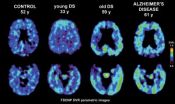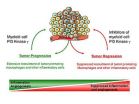(Press-News.org) NEW YORK – The U.S. Food and Drug Administration (FDA) has approved the first clinical trial in humans of a new technology: Cornell Dots, brightly glowing nanoparticles that can light up cancer cells in PET-optical imaging.
A paper describing this new medical technology, "Multimodal silica nanoparticles are effective cancer-targeted probes in a model of human melanoma," will be published June 13, 2011 in the Journal of Clinical Investigation (July 2011). This is a collaboration between Memorial Sloan-Kettering Cancer Center (MSKCC), Cornell University, and Hybrid Silica Technologies, a Cornell business start-up.
For the first time, scientists report a uniquely advanced and comprehensive characterization of Cornell Dots – an ultra small, cancer-targeted, multimodal silica nanoparticle – which has recently been approved as an "investigational new drug" (IND) by the FDA for a first-in-human clinical trial, says Michelle S. Bradbury, M.D., of the Memorial Sloan-Kettering Cancer Center and an assistant professor of radiology at Weill Cornell Medical College.
Cornell Dots are silica spheres less than 8 nanometers in diameter that enclose several dye molecules. (A nanometer is one-billionth of a meter, about the length of three atoms in a row.) The silica shell, essentially glass, is chemically inert and small enough to pass through the body and out in the urine. For clinical applications, the dots are coated with polyethylene glycol (PEG) so the body will not recognize them as foreign substances.
A guiding light within the body: To make the dots stick to tumor cells, organic molecules that bind to tumor surfaces or even specific locations within tumors can be attached to the PEG shell. When exposed to near-infrared light, the dots fluoresce much brighter than dye to serve as a beacon to identify the target cells. The technology, the researchers say, enables visualization during surgical treatment, showing invasive or metastatic spread to lymph nodes and distant organs, and can show the extent of treatment response.
Hooisweng Ow, a coauthor of the paper and once a graduate student working with Ulrich Wiesner, Cornell Professor of Materials Science and Engineering, developed first-generation Cornell dots in 2005. Together, Wiesner, Ow and Kenneth Wang, have co-founded the company Hybrid Silica Technologies (HST) to commercialize the invention. The combined team of MSKCC, Cornell and HST researchers is now in the process of forming a new commercial entity in New York City that will help transition the research into commercial products that will benefit cancer patient care.
"This is the first FDA IND approved inorganic particle platform of its class and properties that can be used for multiple clinical indications, two of which are explored: cancer targeting for diagnostics and future therapeutic diagnostics, as well as cancer disease staging and tumor burden assessment via lymph node mapping," says Bradbury.
The Cornell Dots were optimized for efficient renal clearance, allowing the body to pass them through the kidneys.
In addition, the scientists were able to perform real-time imaging of lymphatic drainage patterns and particle clearance rates, as well as sensitively detect nodal metastases. Nodal mapping is now being pursued under a new award of a BioAccelerate NYC Prize from the Partnership for New York City and the New York City Economic Development Corporation, which is expected to lead to another clinical trial in humans.
The lead authors of the paper are Miriam Benezra and Oula Penate-Medina, who are researchers at MSKCC. Bradbury and Wiesner are the senior authors.
###
Cornell Media Contact:
Blaine Friedlander
bpf2@cornell.edu
(607) 254-8093
Memorial Sloan-Kettering Media Contact:
Christine Hickey
hickey1@MSKCC.ORG
(212) 639-3573
Glowing Cornell dots -- a potential cancer diagnostic tool set for human trials
2011-06-14
ELSE PRESS RELEASES FROM THIS DATE:
More genetic diseases linked to potentially fixable gene-splicing problems
2011-06-14
PROVIDENCE, R.I. [Brown University] — A new Brown University computer analysis that predicts the effect of genetic mutations on how the body splices mRNA indicates as many as a third of disease-related mutations may be linked to splicing problems — more than double the proportion previously thought.
"Something like 85 percent of the mutations in the Human Gene Mutation Database are presumed to affect how proteins are coded, but what this work shows is that 22 percent of those are affecting the splicing process," said William Fairbrother, assistant professor of biology ...
Decoding chronic lymphocytic leukemia
2011-06-14
A paper published online on June 13 in the Journal of Experimental Medicine (www.jem.org) identifies new gene mutations in patients with chronic lymphocytic leukemia (CLL)—a disease often associated with lack of response to chemotherapy and poor overall survival.
CLL is the most common leukemia in the Western world, but the disease varies greatly from patient to patient with regard to prognosis, survival, and disease course. In attempt to understand the genetic basis for this heterogeneity, a group led by Riccardo Dalla-Favera at Columbia University and Gianluca Gaidano ...
NIH researchers find new clues about aging
2011-06-14
National Institutes of Health researchers have identified a new pathway that sets the clock for programmed aging in normal cells. The study provides insights about the interaction between a toxic protein called progerin and telomeres, which cap the ends of chromosomes like aglets, the plastic tips that bind the ends of shoelaces.
The study by researchers from the National Human Genome Research Institute (NHGRI) appears in the June 13, 2011 early online edition of the Journal of Clinical Investigation.
Telomeres wear away during cell division. When they degrade sufficiently, ...
Sniffing out a new source of stem cells
2011-06-14
A team of researchers, led by Emmanuel Nivet, now at the Salk Institute for Biological Studies, La Jolla, has generated data in mice that suggest that adult stem cells from immune system tissue in the smell-sensing region of the human nose (human olfactory ecto–mesenchymal stem cells [OE-MSCs]) could provide a source of cells to treat brain disorders in which nerve cells are lost or irreparably damaged.
Stem cells are considered by many to be promising candidate sources of cells for the regeneration and repair of tissues damaged by various brain disorders (including traumatic ...
JCI online early table of contents: June 13, 2011
2011-06-14
EDITOR'S PICK: Sniffing out a new source of stem cells
A team of researchers, led by Emmanuel Nivet, now at the Salk Institute for Biological Studies, La Jolla, has generated data in mice that suggest that adult stem cells from immune system tissue in the smell-sensing region of the human nose (human olfactory ecto–mesenchymal stem cells [OE-MSCs]) could provide a source of cells to treat brain disorders in which nerve cells are lost or irreparably damaged.
Stem cells are considered by many to be promising candidate sources of cells for the regeneration and repair ...
Brain scan identifies patterns of plaques and tangles in adults with Down syndrome
2011-06-14
In one of the first studies of its kind, UCLA researchers used a unique brain scan to assess the levels of amyloid plaques and neurofibrillary tangles — the hallmarks of Alzheimer's disease — in adults with Down syndrome.
Published in the June edition of the Archives of Neurology, the finding may offer an additional clinical tool to help diagnose dementia in adults with Down syndrome, a genetic disorder caused by the presence of a complete or partial extra copy of chromosome 21.
Adults with this disorder develop Alzheimer's-like plaque and tangle deposits early, ...
Chillingham cattle cowed by climate change
2011-06-14
Spring flowers are opening sooner and songbirds breeding earlier in the year, but scientists know little about how climate change is affecting phenology – the timing of key biological events – in UK mammals. Now, a new study on Northumberland's iconic Chillingham cattle published in the British Ecological Society's Journal of Animal Ecology shows climate change is altering when these animals breed, and fewer calves are surviving as a result.
The team of ecologists lead by Dr Sarah Burthe of the Centre for Ecology & Hydrology were able to use the cattle to discover more ...
Pacemaker implantation for heart failure does not benefit nearly half of the patients
2011-06-14
A new meta-analysis study, led by physician researchers at University Hospitals (UH) Case Medical Center and Case Western Reserve University School of Medicine, and to be published in the Archives of Internal Medicine (embargoed until June 13, 4 p.m. EDT), shows that three-lead cardiac pacemakers implanted in those with heart failure fail to help up to 40 percent of patients with such devices.
"These findings have significant clinical implications and impact tens of thousands of patients in the U.S.," said Ilke Sipahi, MD, Associate Director of Heart Failure and Transplantation ...
Genetic factor controls health-harming inflammation in obese
2011-06-14
CLEVELAND – June 13, 2011 –Researchers at Case Western Reserve University School of Medicine have discovered a genetic factor that can regulate obesity-induced inflammation that contributes to chronic health problems.
If they learn to control levels of the factor in defense cells called macrophages, "We have a shot at a novel treatment for obesity and its complications, such as diabetes, heart disease and cancer," said Mukesh K. Jain, MD, Ellery Sedgwick Jr. Chair, director of the Case Cardiovascular Research Institute, professor of medicine at Case Western Reserve University ...
Promising new target for stifling the growth and spread of cancer
2011-06-14
Cancer and chronic inflammation are partners in peril, with the latter increasing the likelihood that malignant tumors will develop, grow and spread. Researchers at the University of California, San Diego School of Medicine say they've identified a tumor inflammation trigger that is common to most, if not all, cancers. And using existing inhibitory drugs, the scientists were able to dramatically decrease primary tumor growth in animal studies and, more importantly, halt tumor progression and metastasis.
The findings appear in the June 14 issue of the journal Cancer Cell, ...


